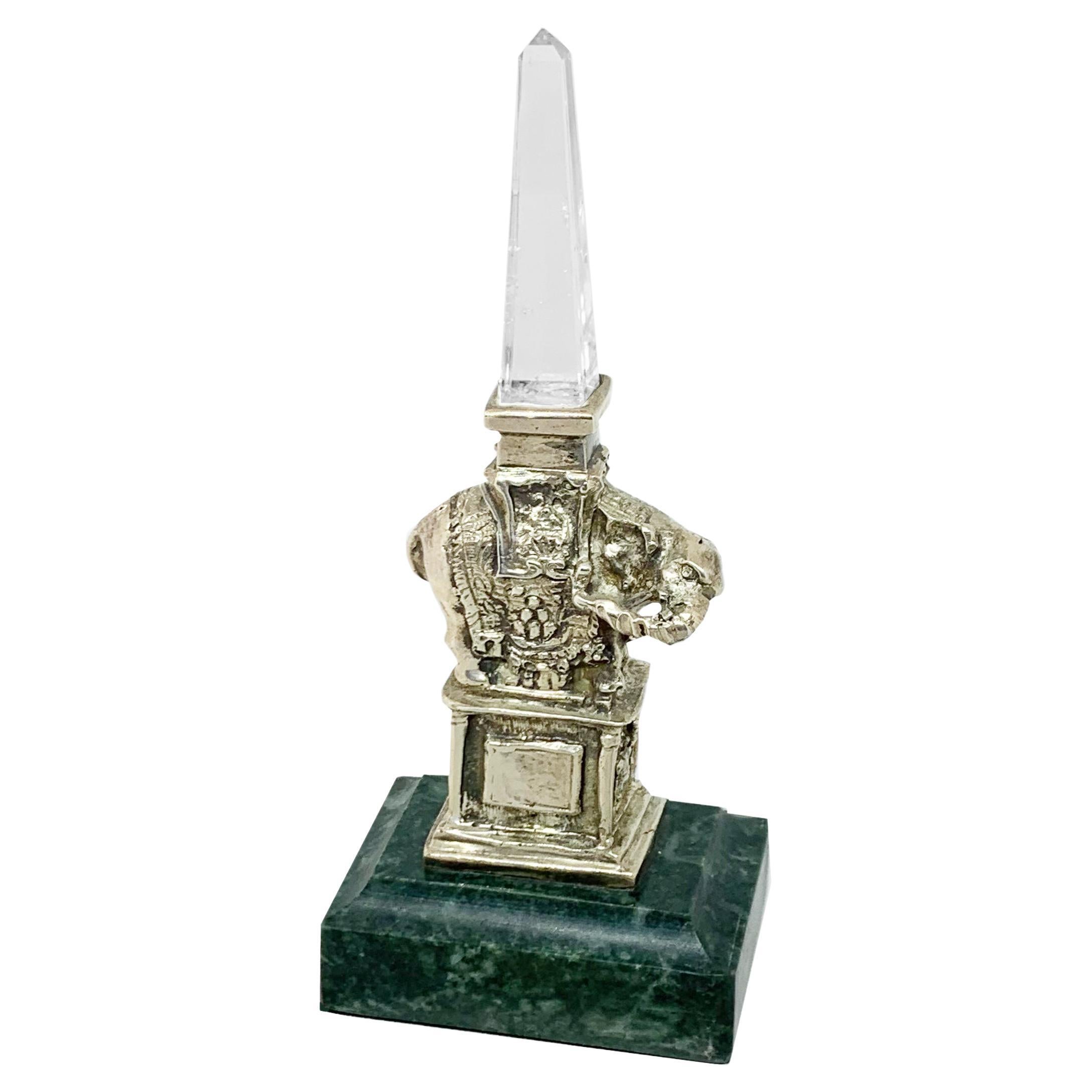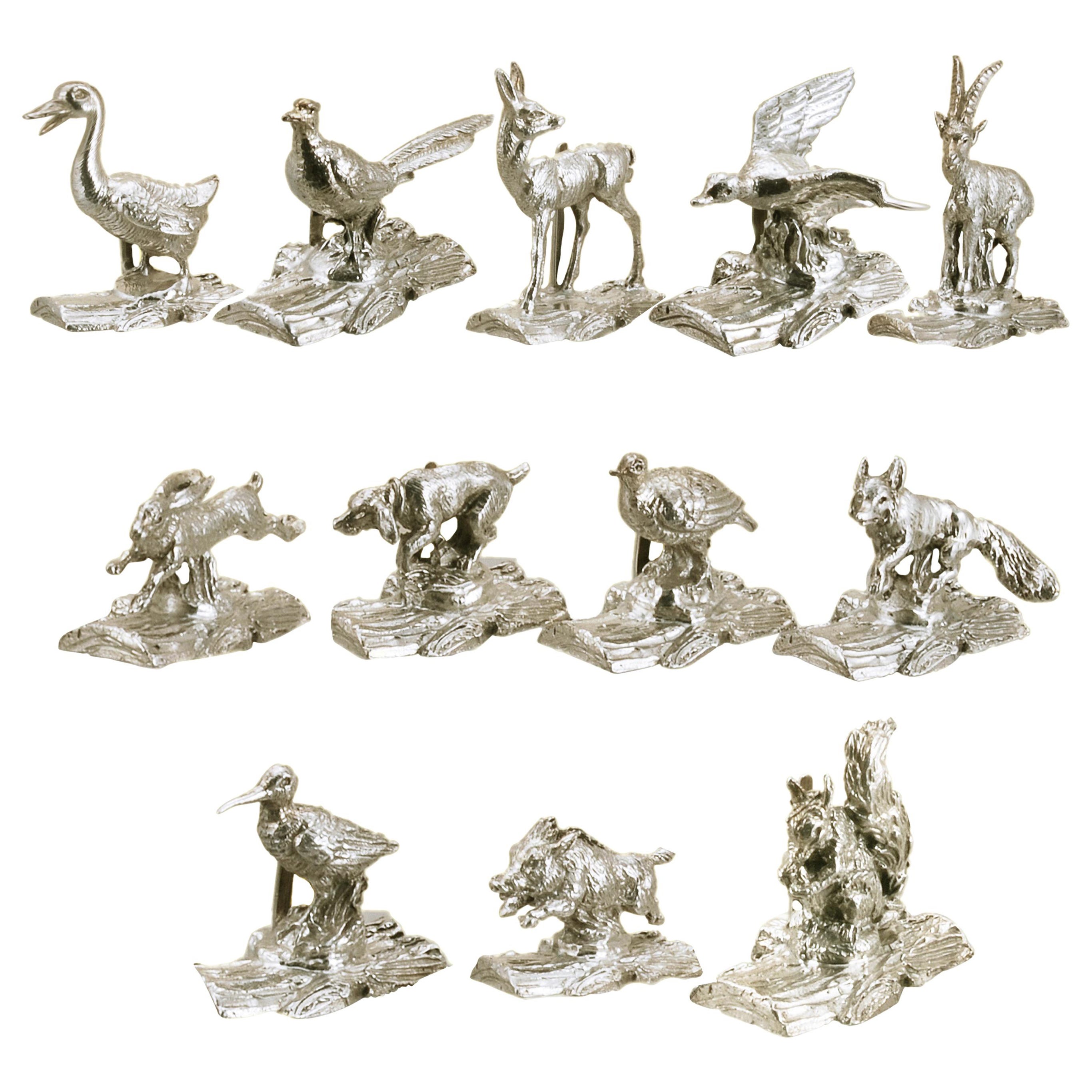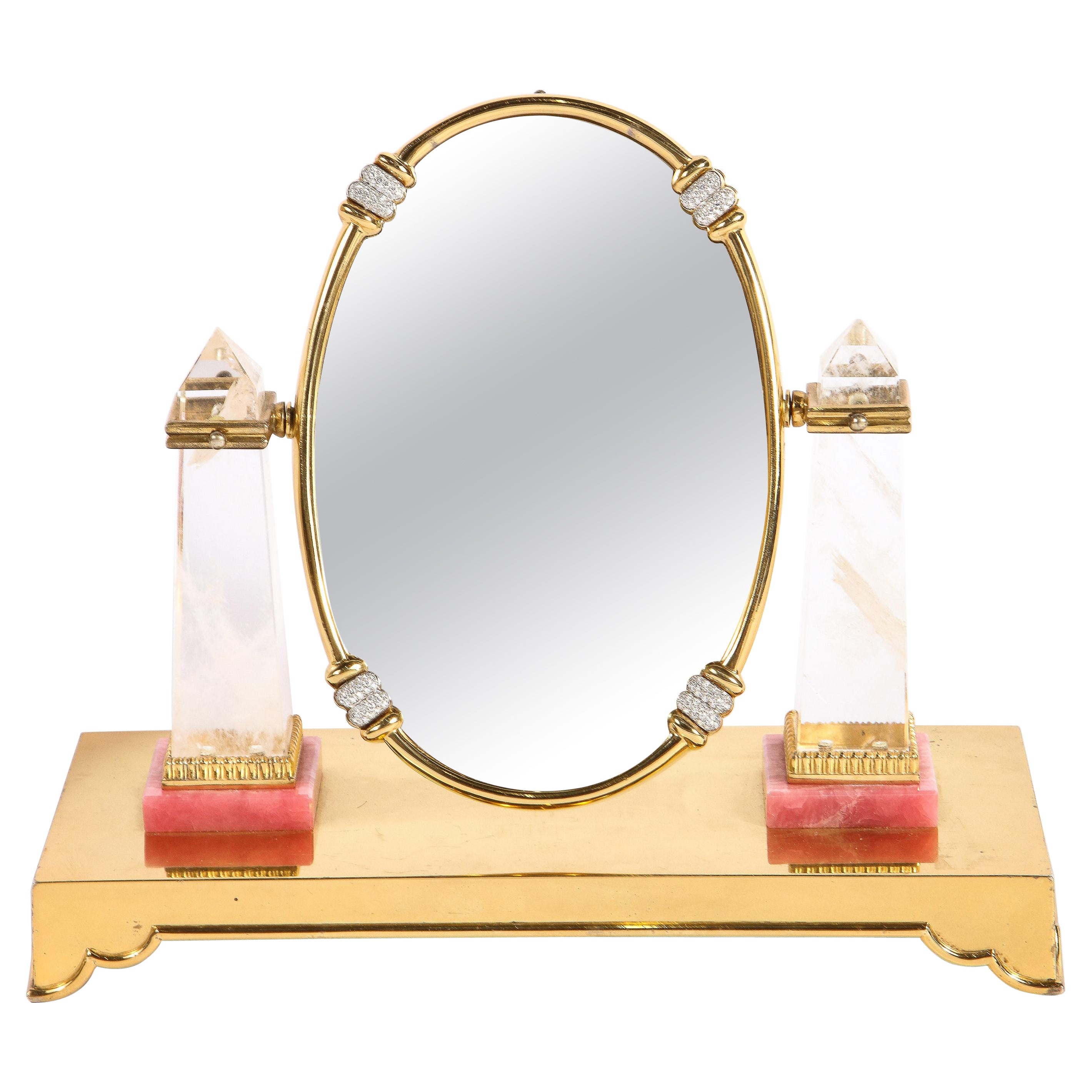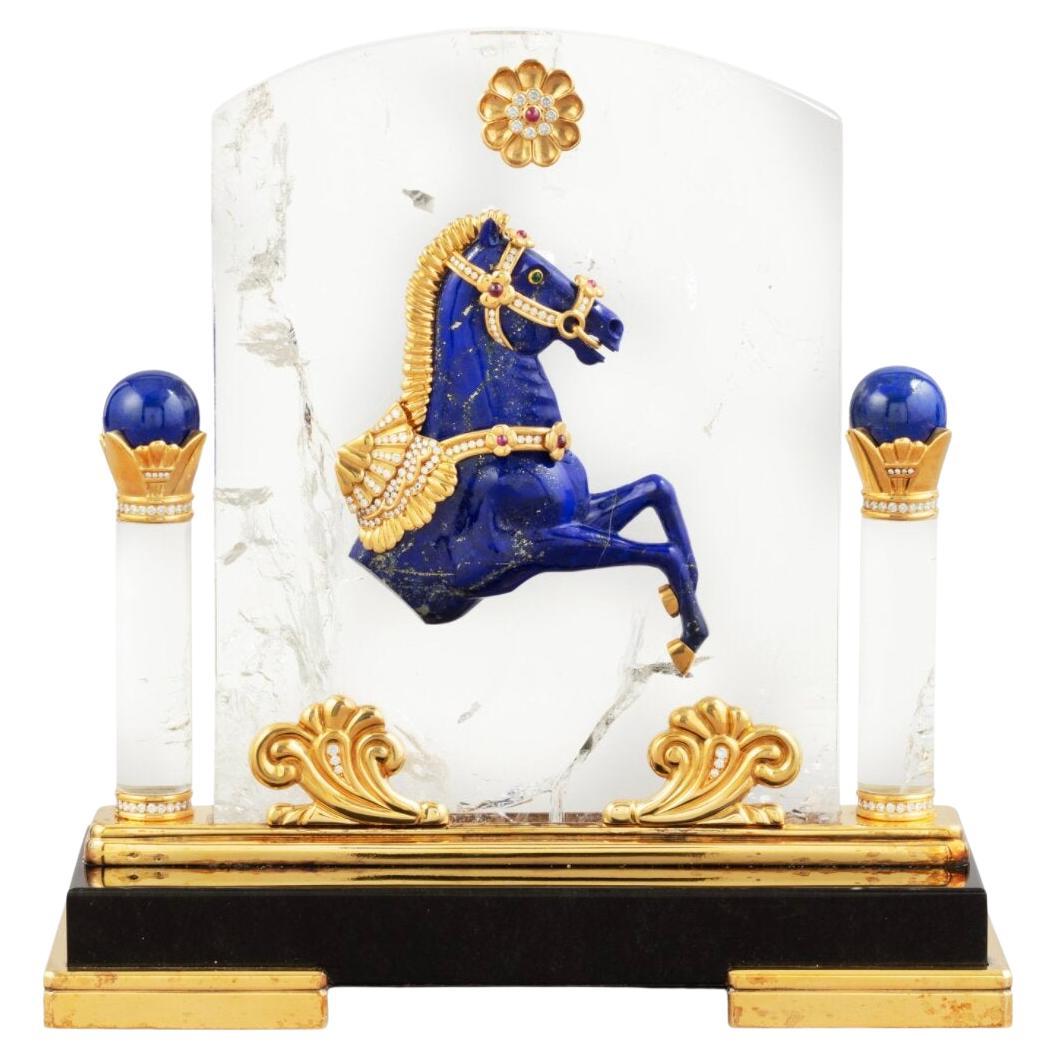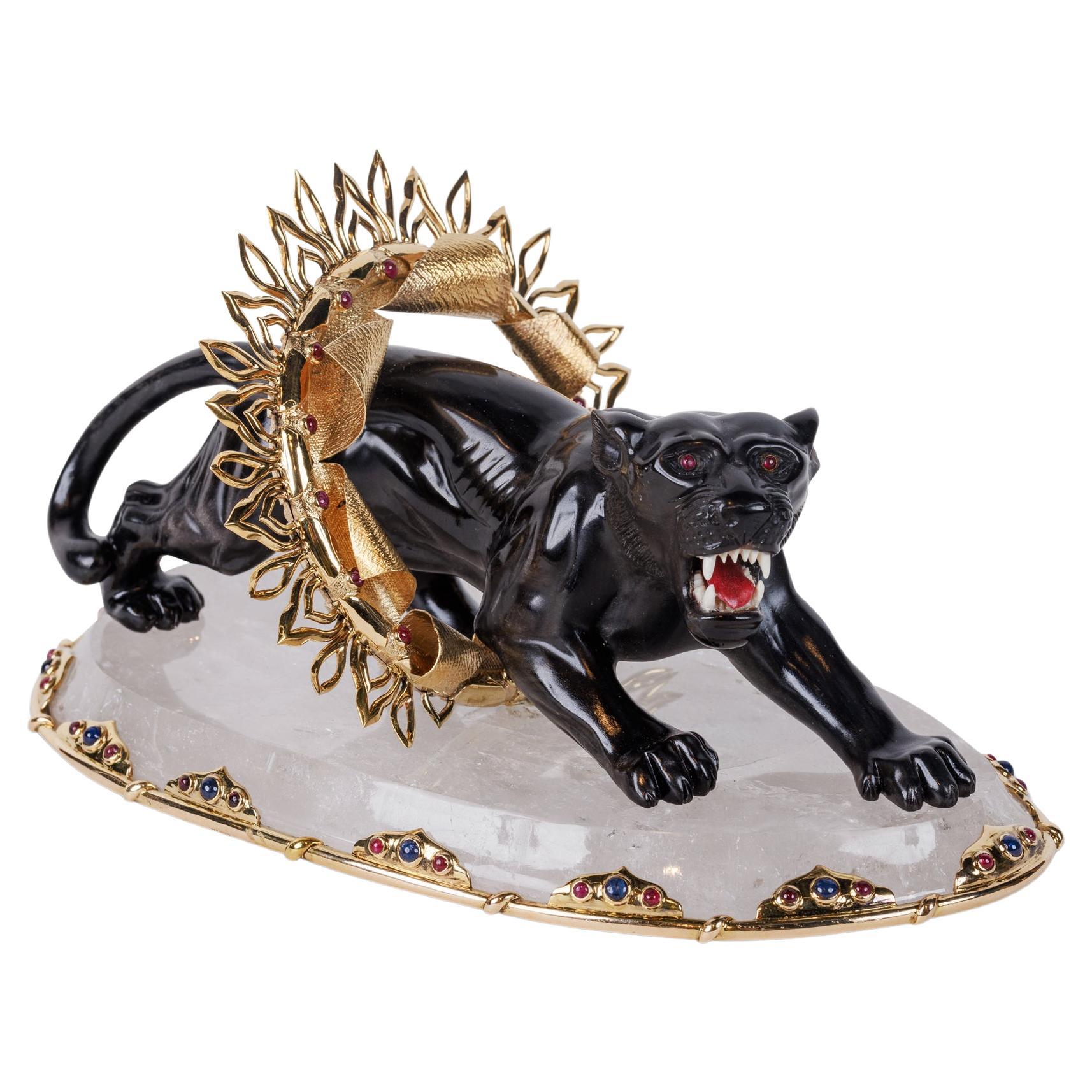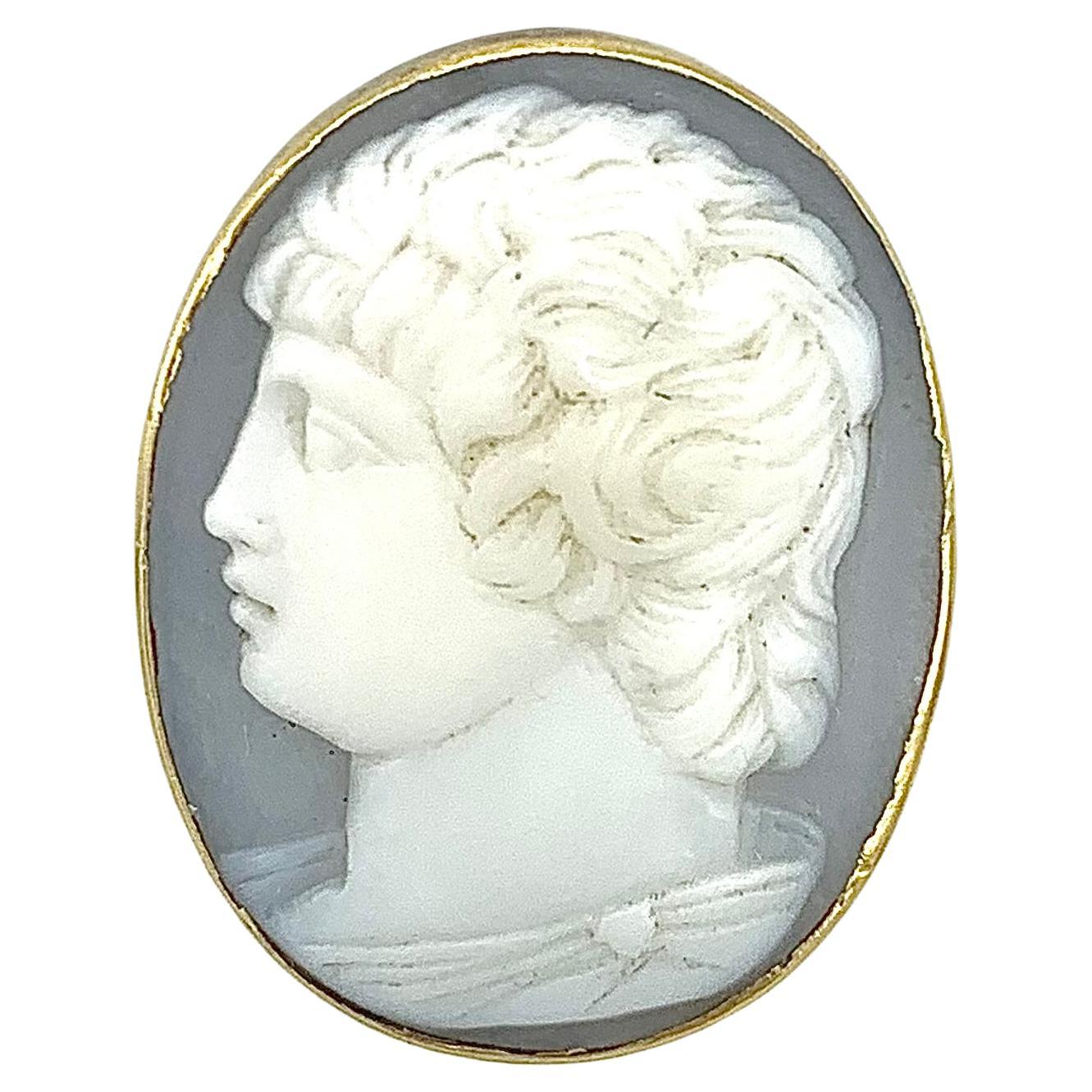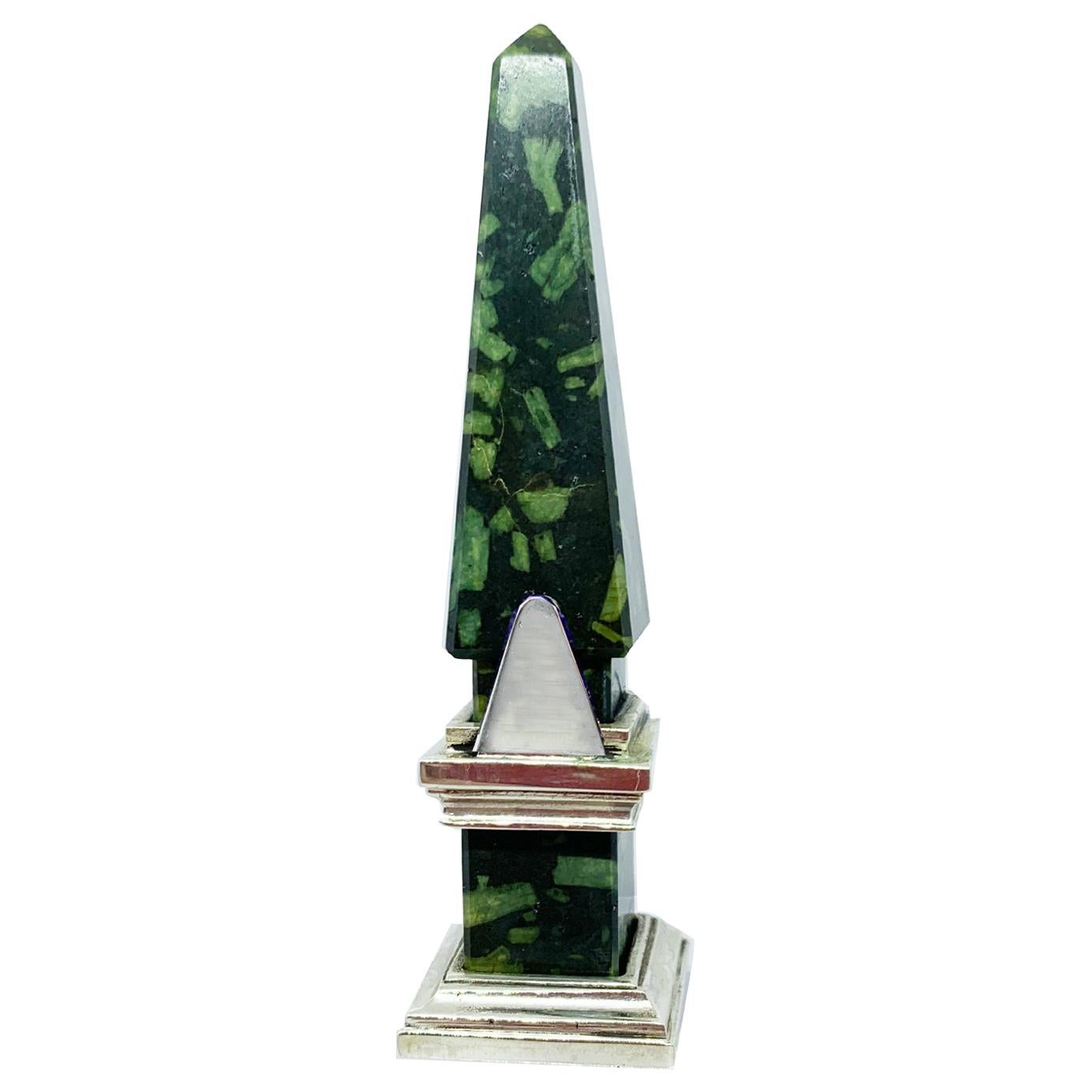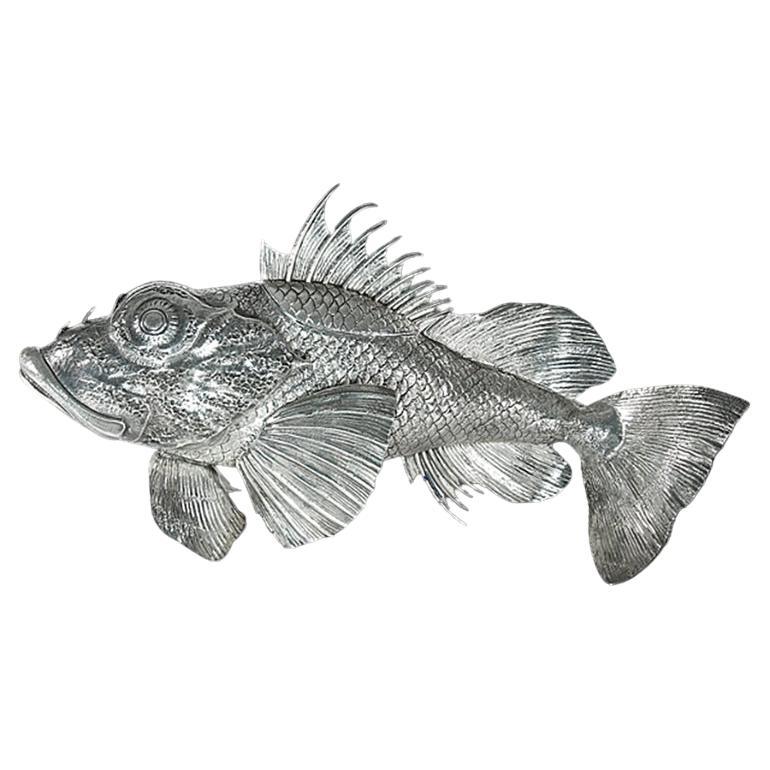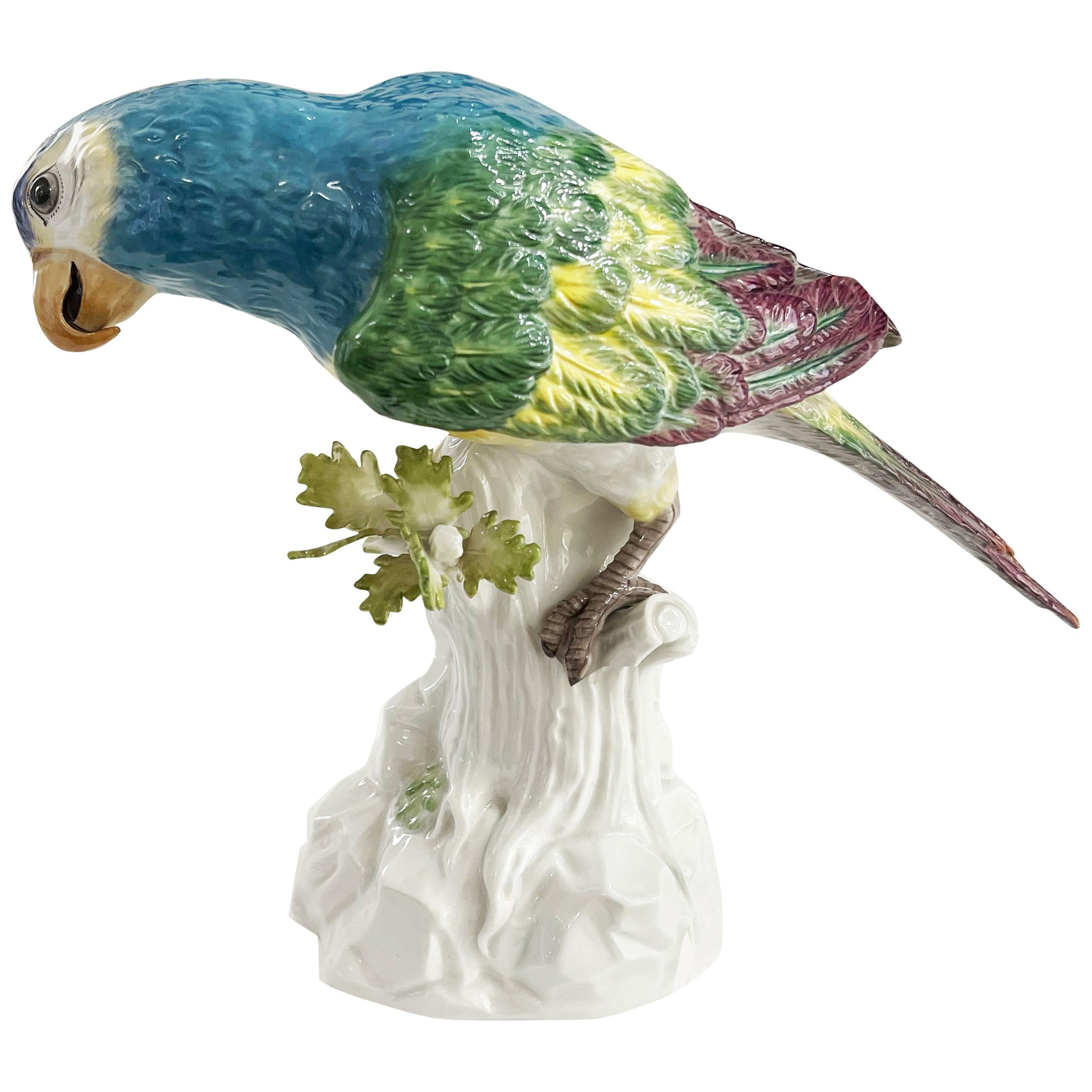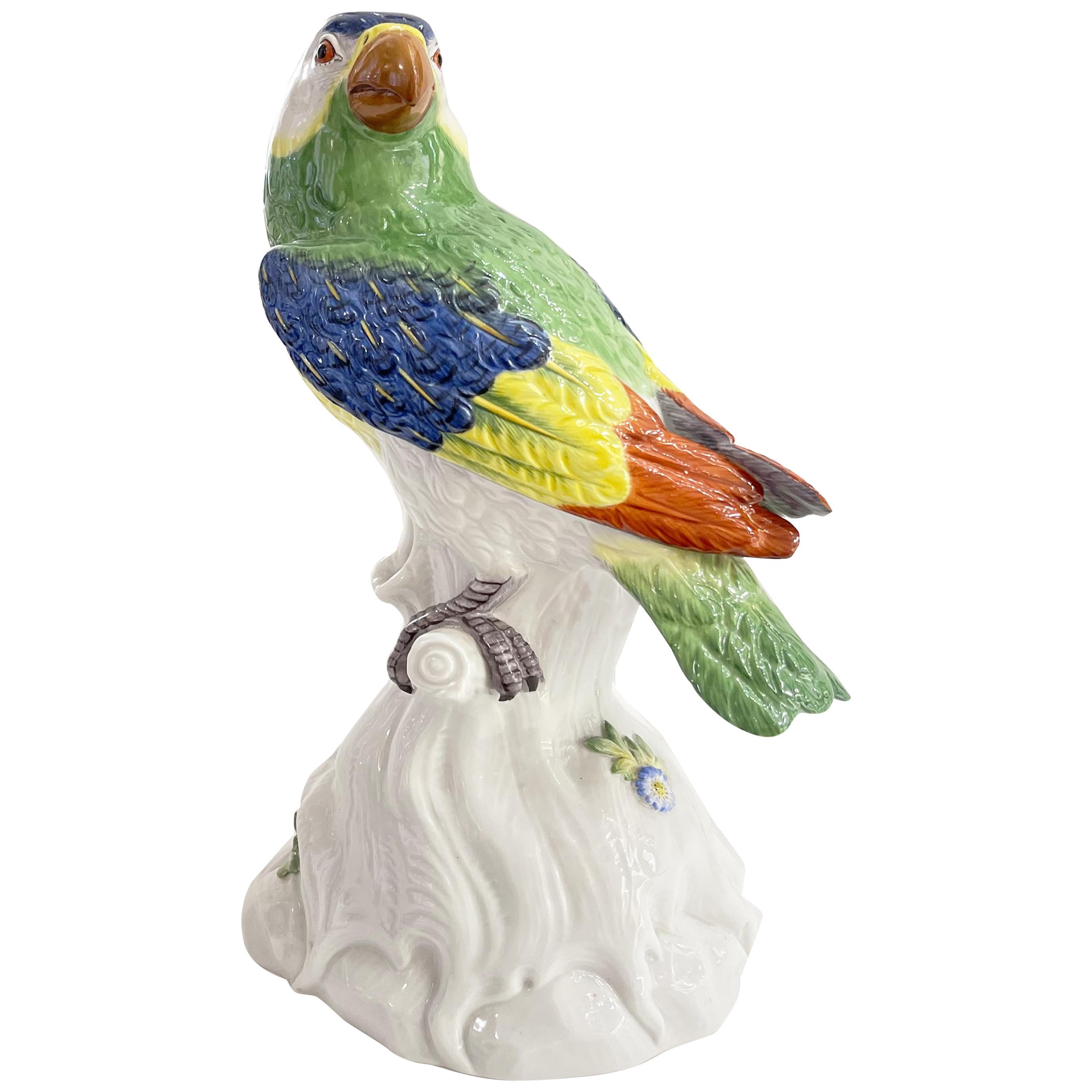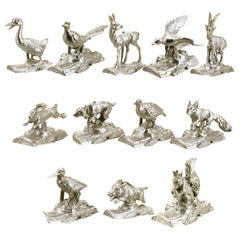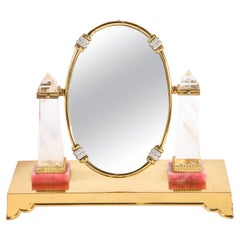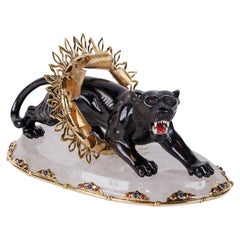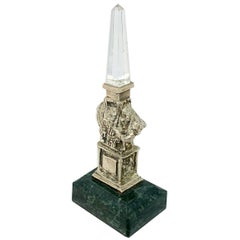
Silver Statue with Rock Crystal Obelisk Reproducing Bernini's "Minerva chick"
View Similar Items
Want more images or videos?
Request additional images or videos from the seller
1 of 5
Silver Statue with Rock Crystal Obelisk Reproducing Bernini's "Minerva chick"
About the Item
- Creator:SERRA
- Metal:
- Stone:
- Stone Cut:
- Dimensions:Height: 5.52 in (140 mm)Width: 1.58 in (40 mm)Length: 2.17 in (55 mm)
- Place of Origin:
- Period:
- Date of Manufacture:2019
- Condition:
- Seller Location:Roma, IT
- Reference Number:1stDibs: LU1922210282462
About the Seller
5.0
Vetted Seller
These experienced sellers undergo a comprehensive evaluation by our team of in-house experts.
1stDibs seller since 2020
34 sales on 1stDibs
Typical response time: 4 hours
More From This SellerView All
- Silver Statue with Rock Crystal Obelisk Reproducing Bernini's "Minerva Chick"Located in Roma, ITThis sterling silver and rock crystal statue was made by our talented Roman artisans, and reproduces a famous monument in Rome. Adjacent to the Pantheon...Category
2010s Italian Figurines and Sculptures
MaterialsRock Crystal, Sterling Silver
- Set of 12 Placeholder-Animals in Sterling SilverLocated in Roma, ITThese 12 sterling silver animals are handmade by our artisans with the ancient techniques of lost wax casting and chisel. They serve to embellish and enrich the set table. Behind ea...Category
2010s Italian Figurines and Sculptures
MaterialsSterling Silver
- Fountain of the Turtles in Sterling Silver and Travertine Base 'Rome, 1581'Located in Roma, ITIn Rione XI - Sant'Angelo, a few steps from the Old Jewish Quarter, surrounded by the palaces that once belonged to the noble Mattei family who gave the square its name, stands one o...Category
Vintage 1970s Italian Classical Roman Figurines and Sculptures
MaterialsSterling Silver
- Sterling Silver Stirrup Cup 'Deer’Located in Roma, ITThis deer is one of 12 exclusive Serra's sterling silver "stirrup glasses", (weight 360 gr circa ) models date back to around the mid-1900s, and represent 12 animals that can be placed on the table to serve wine. Te Our 12 glasses are now used to be added to other crystal glasses, maybe to serve a special wine! In this difficult historical period for our health, drinking from silver glasses is really a great help: silver is rich in antibacterial and antimicrobial properties that eradicate the bacteria and antibiotic-resistant pathogens. It can be used as a natural disinfectant of any liquid. Silver is a natural immunity booster . Its nanoparticles create an immunomodulatory activity that gives you a healthy immune system. Popular since the late 18th and 19th century, antique silver stirrup cups...Category
2010s Italian Figurines and Sculptures
- Authentic Roman Marble 'Serpentino' Sterling Silver Place-Holder ObeliskLocated in Roma, ITThis obelisk in "Lapis lacedaemonius", called in ancient Rome "Serpentino", was made by our talented artisans: the one who cut the precious ancient marble and the one who made the st...Category
2010s Italian Classical Roman Figurines and Sculptures
MaterialsSterling Silver
- Hand Painted Multicolored Porcelain Parrot, Meissen ManufactoryLocated in Roma, ITThis beautiful parrot was made by the Meissen factory, perhaps the oldest and most prestigious porcelain factory in Europe, using the model created by Kandler in the 1700s. In 1731 t...Category
2010s German Figurines and Sculptures
You May Also Like
- Exquisite Italian Silver-Gilt, Diamond, Rock Crystal, & Rhodochrosite MirrorLocated in New York, NYAn Exquisite Italian Silver-Gilt, Diamond, Rock Crystal, and Rhodochrosite Vanity Mirror, by Moba Italy. Circa 1950 Very fine and impressive vanity mirror made in solid sterling gi...Category
20th Century Italian Art Deco Vanity Items
MaterialsDiamond, Rock Crystal, Silver
- Mellerio Paris, a French Gold, Diamond, Silver-Gilt, Rock-Crystal, & Lapis HorseBy Mellerio ParisLocated in New York, NYMellerio Paris, A French Gold, Diamond, Silver-Gilt, Rock-Crystal, Obsidian & Lapis Horse An extremely rare and unique, one of a kind French gold, diamonds, Silver-gilt rock-crystal, obsidian and lapis lazuli jeweled sculpture "Bucéphale, Chevaux de légende", "Bucephalus, A Legendary Horse" by Mellerio, Paris, circa 1998. Sitting on black obsidian base, the solid rock crystal slab is finely applied with a lapis lazuli half-horse with harness mounted in 18k gold and brilliant cut diamonds, between two crystal and lapis lazuli columns adorned with gold and diamonds, insert with 7 ruby cabochons and 1 emerald cabochon, the obsidian base with a plaque engraved: CHEVAUX DE LEGENDE / MELLERIO DITS MELLER / PARIS / 5029 DIV Bucephalus (c355-326 BC) is among the most famous horses in history, and it was said that this he could not be tamed. The young Alexander the Great, of course, tamed him – and went on to ride his beloved equine companion for many years and into many battles. The piece is in excellent condition and comes with a custom made wood case made for transport. It's very elegant and has French hallmarks throughout. A truly magnificent piece. Measures 10" high x 9" wide x 4" deep Founded in France in 1613 by the descendants of Italian immigrants from the Vigezzo Valley in the north of Italy, Mellerio is one of the oldest jewellery houses in Europe. The family business soon attracted the attention of the Royal Court and Marie Antoinette herself reportedly purchased a precious bracelet featuring 7 cameos surrounded by rubies in 1780. Later on, in the 19th century, Mellerio became the official supplier of the French Royal family and the Court of Netherland. Mellerio creates many jewellery items, all set with rare gems such as peridots, amethysts, aquamarines, citrines and topaz, applying for a patent, the flexible stem, a very supple and light jewellery mechanism. Mellerio remains also well known for their spectacular series of Art Nouveau jewels, created at the beginning of the 20th century, as well as for the creation of trophies rewarding some of the greatest footfall and tennis players of history. In 1993, the jewellery house launched their first watch collection. Today, Mellerio has stores in Paris, Japan and Hong Kong. July 14, 1789: this date is known throughout the world as the beginning of the French Revolution. According to a ledger belonging to House of Mellerio, this was also the day that the jeweler sold a golden key to the Comte de Coutance for 10 livres. This ledger, as well as inventories dating as far back as 1768, are the jeweler’s oldest archives. These archives have continued to grow over the years, as the House, established on rue de la Paix in Paris, still lives on today, still in the hands of the same family from Craveggia, in the North of Italy. The tumultuous history of the Mellerio family in France probably goes as far back as the Italian wars of the Renaissance, but the first official document proving their commercial activity in Paris dates back to 1613. This document is the famous royal warrant awarded by Marie de Medici to a number of Italian families established along the rue des Lombards, including the Mellerios, allowing them to sell “small jewelery items”, therefore granting them a small exception to the traditional monopoly enjoyed by Parisian jewelers. At that time, powerful corporations regulated the operations and customs of Parisian business, but thanks to this exceptional warrant, the Mellerios managed to escape the confines of this framework. Today, this wax-sealed document is kept at the city hall of Craveggia. From 1613 to the Revolution, the Mellerios lived between France and Italy. The corporations tried many times to put an end to their trade privileges, but all in vain, as a dynasty of sovereigns renewed the warrant. Always marrying and often retiring in Craveggia, the Mellerios continued to maintain their jewelry business in Paris. At first, they did this without a shop. Wearing backpacks (wooden boxes divided into small compartments where jewels were kept), they would tour town fairs around Paris and royal castles. This is how Jean-Baptiste Mellerio (1765-1850) is said to have sold a bracelet set with rubies and Antique cameos to Marie-Antoinette, which still exists today. Many elements seem to prove the veracity of this anecdote. The queen was particularly fond of cameos, which cover the entire background of her famous jewelry cabinet, and ruby was her favorite stone after diamond. The famous bracelet, reacquired a few years ago by the House of Mellerio, is indeed an 18th century jewel, set with antique cameos representing the profiles of Roman emperors. Two branches of the family were operating in Paris during this time, under the reign of Louis XVI: that of Jean-François (1746-1828), the paternal ancestor of the current Mellerios, and that of Jean-Baptiste (1765-1850). The French Revolution forced them to return to Italy. However, both Jean-Baptiste and François Mellerio (1772-1843), who was the son of Jean-François, were eventually able to return to Paris after the founding of the Consulate. Jean-Baptiste opened a shop at the Iron Crown of rue Vivienne, and François opened his at the Palais des Tuileries, rue du Coq Saint-Honoré. His well-organized order books give an idea of his high-ranking clientele during the “Old Regime”, among which were the Comte and Comtesse Octave de Segur, the Marquise (later Duchess) de Tourzel, former governess of the royal children, and her daughter, the Comtesse de Bearn, the Craufurds -who organized the flight to Varennes, the Duc and Duchess de Gramont, the Comtesse de Boigne, and Madame de Souza, Talleyrand’s mistress. We also see the names of the imperial family: Empress Josephine, the Queen of Holland, Princess Elisa, Caroline and Pauline. At that time, the House of Mellerio specialized, among other things, in the trade of antique cameos, a newly fashionable genre of jewel that captured the imagination of all the princesses and noble women of the time. The years of the Restauration and July Monarchy were among the most glorious. The Bourbons were back on the throne, and the clientele of the House of Mellerio had regained its former wealth. Mellerio supplied Louis-Philippe, Duke of Orléans, as well as his mother, wife and sister, with sumptuous jewels, including a set of emeralds made piece by piece, while the Duke of Bourbon, last prince of the House of Condé, offered diamonds to his mistress, the scheming Baronne de Feucheres, and Monsieur de LaFayette also bought cameos for one of his granddaughters. For the first time, Mellerio ventured into the world of arts in 1815, when Carlotta Grisi, a famous dancer who created Giselle, as well as an actress named Rachel, bought jewels at the Mellerio store on rue de la Paix. 1848 marked a new turning point. France once again became a Republic. François Mellerio handed the company over to his son, Jean, and the latter decided to travel to Spain to build a new clientele. He later became one of the jewelers of the royal family, and met Eugénie de Montijo, who remained a faithful client when she became empress of the French people. The Imperial years were lavish. During the Second Empire, Paris was a pageant of crinoline dresses designed by Worth, while jewels by Mellerio, Worth’s neighbour on the rue de la Paix, adorned the noble women of the Tuileries court. The Empress bought pearls. Mathilde Bonaparte...Category
21st Century and Contemporary French Figurines and Sculptures
MaterialsDiamond, Lapis Lazuli, Rock Crystal, Gold, Silver
- Alexandre Reza, Rare Obsidian, Silver-Gilt, and Rock Crystal Circus PantherLocated in New York, NYAlexandre Reza, A Rare Obsidian, Silver-Gilt, and Rock Crystal Circus Panther, mounted with Cabochon Sapphires and Rubies. "Panthère au cirque"" / Panther at the circus" - an exquisite jeweled mounted objet. 5.5" high x8" wide x 4.5" deep. In very good condition, no damages noted. Ready to place. In its original presentation box from Maison Alexandre Reza. Alexandre Reza (November 1, 1922 – January 15, 2016) was a Paris-based jeweler known for his diverse and rare collection of precious gemstones.He is lauded as the greatest gem collector of modern times. Alexandre Reza was born in 1922 in Moscow, of ancient Samarkand heritage. The son of a jeweler, he moved to France with his family when he was a child. He set out on his own at the age of eighteen, the same time as the onset of World War II. After the war, he began his career as a diamond expert, traveling extensively to source each stone, which served as the key design inspiration for his work.Early on, he supplied gems to jewelry brands such as Boucheron, Bulgari, Cartier, Chaumet, Harry Winston, Louis Gérard...Category
20th Century French Art Deco Figurines and Sculptures
MaterialsRock Crystal, Ruby, Blue Sapphire, Silver
- Antique 18th Century Button Cameo of a Young Man Shell Carving SilverLocated in Munich, BavariaThis rare button features a shell cameo of a young man carved in antique manner. The cameo is mounted in a silver button.Category
Antique 1780s European George III Figurines and Sculptures
MaterialsSilver
- Buccellati Silver Sea Rock Fish CenterpieceBy BuccellatiLocated in New York, NYBuccellati centerpiece measure approx. 24" in length, 14" in width, 12" in height. The top portion of this piece opens; revealing a cavity that measures approx. 3" by 5 1/2". Includ...Category
Vintage 1960s Figurines and Sculptures
MaterialsSilver, Sterling Silver
- Antique Foster & Bailey Enamel, Sterling Silver & Crystal Vanity JarBy Foster and BaileyLocated in New York, NYEdwardian Art Nouveau vanity jar. Made by Foster & Bailey in Providence, ca 1910. Crystal with curved sides and short inset neck. Cut geometric ornament and stylized flower band; star on underside. Cover sterling...Category
Early 20th Century American Edwardian Vanity Items
MaterialsSterling Silver, Enamel
